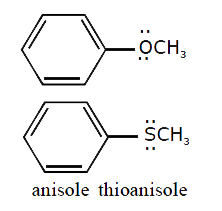Explain why nitration of nitrobenzene gives m-dinitrobenzene and not o- and p-dinitroenzene.
To understand why nitration of nitrobenzene predominantly yields m-dinitrobenzene instead of o- and p-dinitrobenzene, we can break down the reasoning into a series of steps:
Step 1: Understand the Structure of Nitrobenzene
Nitrobenzene is a benzene ring with a nitro group (−NO₂) attached to it. The nitro group is an electron-withdrawing group due to its strong electronegativity and resonance effects.
Step 2: Identify the Directing Effects of the Nitro Group
The nitro group is a meta-directing group in electrophilic aromatic substitution reactions. This means that when a second nitro group is introduced to the benzene ring during nitration, it will preferentially direct the incoming electrophile (the nitronium ion, NO₂⁺) to the meta position relative to itself rather than the ortho or para positions.
Step 3: Analyze the Electron Density at Different Positions
When the nitro group is present on the benzene ring, it withdraws electron density from the ring through resonance and inductive effects. This reduction in electron density affects the ortho and para positions more significantly than the meta position.
- Ortho and Para Positions: The electron density at these positions is decreased due to the presence of the nitro group. This makes them less favorable for the attack of the electrophile.
- Meta Position: The meta position retains a relatively higher electron density compared to the ortho and para positions, making it more favorable for electrophilic attack.
Step 4: Nitration Reaction Conditions
In the nitration process, concentrated nitric acid (HNO₃) and concentrated sulfuric acid (H₂SO₄) are used to generate the nitronium ion (NO₂⁺). When this ion attacks nitrobenzene, it is more likely to attack the meta position due to the reasons discussed.
Step 5: Conclusion
As a result of the electron-withdrawing nature of the nitro group, the nitration of nitrobenzene predominantly leads to the formation of m-dinitrobenzene rather than o- or p-dinitrobenzene.
Summary
In summary, the nitration of nitrobenzene gives m-dinitrobenzene instead of o- and p-dinitrobenzene because:
- The nitro group is an electron-withdrawing group that decreases electron density at the ortho and para positions.
- The meta position retains relatively higher electron density, making it more favorable for electrophilic attack.
Nitrobenzene is a benzene ring with a nitro group (−NO₂) attached to it. The nitro group is an electron-withdrawing group due to its strong electronegativity and resonance effects.
The nitro group is a meta-directing group in electrophilic aromatic substitution reactions. This means that when a second nitro group is introduced to the benzene ring during nitration, it will preferentially direct the incoming electrophile (the nitronium ion, NO₂⁺) to the meta position relative to itself rather than the ortho or para positions.
When the nitro group is present on the benzene ring, it withdraws electron density from the ring through resonance and inductive effects. This reduction in electron density affects the ortho and para positions more significantly than the meta position.
- Meta Position: The meta position retains a relatively higher electron density compared to the ortho and para positions, making it more favorable for electrophilic attack.
In the nitration process, concentrated nitric acid (HNO₃) and concentrated sulfuric acid (H₂SO₄) are used to generate the nitronium ion (NO₂⁺). When this ion attacks nitrobenzene, it is more likely to attack the meta position due to the reasons discussed.
As a result of the electron-withdrawing nature of the nitro group, the nitration of nitrobenzene predominantly leads to the formation of m-dinitrobenzene rather than o- or p-dinitrobenzene.
In summary, the nitration of nitrobenzene gives m-dinitrobenzene instead of o- and p-dinitrobenzene because:
- The nitro group is an electron-withdrawing group that decreases electron density at the ortho and para positions.
- The meta position retains relatively higher electron density, making it more favorable for electrophilic attack.
Topper's Solved these Questions
- BOOK - PRADEEPCHAPTER - ORGANIC COMPOUNDS CONTAINING NITROGENEXERCISE - COMPETITION FOCUS JEE (MAIN AND ADVANCED)/MEDICAL ENTRANCE SPECIAL (VII. ASSERTION-REASON TYPE QUESTIONS) TYPE - II9videos
ORGANIC COMPOUNDS CONTAINING NITROGEN
- BOOK - PRADEEPCHAPTER - HALOALKANES AND HALOARENESEXERCISE - IMPORTANT QUESTIONS FOR BOARD EXAMINATION22videos
HALOALKANES AND HALOARENES
- BOOK - PRADEEPCHAPTER - P-BLOCK ELEMENTS EXERCISE - IMPORTANT QUESTIONS FOR BOARD EXAMINATION25videos
P-BLOCK ELEMENTS
Similar Questions
Knowledge Check
- Question 1 - Select One
Assertion: Nitration of benzene gives mainly m-nitrobenzene.
Reason: In electrophilic nitration of benzene the nucleophile is NO+2.AAssertion and reason both are correct statements and reason is correct explanation for assertion.BAssertion and reason both are correct statements but reason is not correct explanation for assertion.CAssertion is correct statement but reason wrong statement.DAssertion is wrong statement but reason is correct statement. - Question 2 - Select One
Statement-1. The reaction of conc. HNO3 and conc. H2SO4 on nitrobenzene gives m- dinitrobenzene.
Statement-2. The nitro group in benzene ring decreases the electron density in the benzene ring.AStatement-1 is True, Statement-2 is True , Statement-2 is a correct explanation for Statement-1BStatement-1 is True, Statement-2 is True , Statement-2 is not a correct explanation for Statement-1CStatement- 1 is True, Statement-2 is FalseDStatement-1 is False, Statement -2 is True - Question 3 - Select One
Nitration of aniline also gives m - nitroaniline along with o - nitro and p - nitroaniline , in strong acidic medium because
AIn electrophilic substitution reaction amino group is meta directiveBStrong acid , gives nitrate anion , which attacks at m - positionCIn strong acidic medium aniline present as anilinium ionDIn strong acidic medium , nitration of aniline is a nucleophic substitution reaction
Which of the following compounds will have the highest melting point and why ?
o - dichlorobenzene , m - dichlorobenzene and p - dichlorobenzene .View SolutionExplain why does nitro group nitrobenzene direct the incoming group to m-position?
View SolutionExplain why the nitration of anisole is much faster than the nitration of thioanisole under the same con- ditions.
 View Solution
View SolutionBromination of aniline gives 2,4,6 - tribromoaniline where as nitration of aniline gives m -nitroaniline . In case of nitration m -derivatives is fored
View Solutionp−Nitrotoluene on further nitration gives
View Solution

